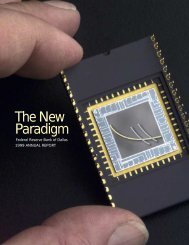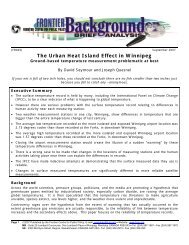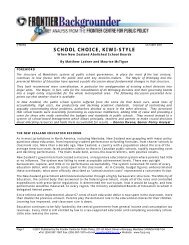The New Paradigm - Federal Reserve Bank of Dallas
Create successful ePaper yourself
Turn your PDF publications into a flip-book with our unique Google optimized e-Paper software.
10<br />
Exhibit 5<br />
America’s Shifting Source <strong>of</strong> Growth<br />
Data on GDP at the detailed industry level are not available.<br />
Employment data, however, reveal a clear shift away from yesterday’s<br />
commodity-based economic growth and toward knowledge-<br />
and network-based expansion. More than 40 percent <strong>of</strong><br />
employment growth in the ’90s came from <strong>New</strong> Economy industries—double<br />
that <strong>of</strong> the 1970s.<br />
Percent <strong>of</strong> total employment growth<br />
45<br />
40<br />
35<br />
30<br />
25<br />
20<br />
15<br />
10<br />
1980<br />
Network economy<br />
1990<br />
1997<br />
Knowledge economy<br />
Prototyping each part <strong>of</strong> a car once took weeks and cost $20,000 on<br />
average. Using an advanced 3-D object printer, Ford has cut the time to<br />
just hours and the cost to less than $20.<br />
<strong>The</strong> Information Age’s invention, innovation and enterprise<br />
forged the <strong>New</strong> Economy. Many <strong>of</strong> the nation’s highgrowth<br />
industries wouldn’t exist without the microprocessor.<br />
High technology now drives the economy. It accounted<br />
for more than 40 percent <strong>of</strong> job growth in the 1990s—double<br />
the rate <strong>of</strong> the 1970s. (See Exhibit 5.)<br />
At the end <strong>of</strong> the ’90s, high tech, telecommunications<br />
and health care—the prime beneficiaries <strong>of</strong> the microprocessor<br />
revolution—made up more than half the market<br />
capitalization <strong>of</strong> America’s 500 largest companies. Three<br />
decades ago, high tech still hadn’t come out <strong>of</strong> the geeks’<br />
garages, and manufacturing and energy accounted for<br />
about half the market capitalization. (See Exhibit 6.) While<br />
the Dow quadrupled, technology stocks jumped 13-fold in<br />
the 1990s, another sign <strong>of</strong> invention and innovation’s<br />
growing importance in the economy.<br />
<strong>The</strong> microprocessor arrived a generation ago, then<br />
began revitalizing American industry in the early 1980s.<br />
Few understood how much the world was changing until<br />
the 1990s, when the Information Age achieved a kind <strong>of</strong><br />
critical mass. It takes time for an invention to spread<br />
through the economy, for spillovers to emerge and for<br />
new products to reach the marketplace. Now that it’s all<br />
coming together, America has new reason to stop seeing<br />
itself through a lens <strong>of</strong> downsizing, inequality and falling<br />
living standards. In the 1990s, thanks largely to the microprocessor<br />
and its spillovers, America witnessed a resurgence<br />
<strong>of</strong> economic growth, new jobs and productivity.<br />
1999 ANNUAL REPORT <strong>Federal</strong> <strong>Reserve</strong> <strong>Bank</strong> <strong>of</strong> <strong>Dallas</strong>

















